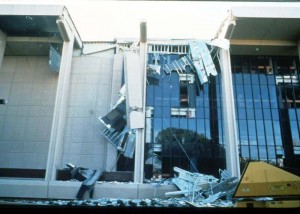 |
Archive for the ‘Featured Web Site’ Category
Monday, May 4th, 2009
The U.S. Geological Survey has made available a wealth of information about earthquakes, among them the “Today in Earthquake History” page . A look at the page for May 4 shows several significant earthquakes around the world, two of which were in Alaska in 1923 and 1934. By looking at the “Earthquake Reports” section in the left menu bar here on the Toolkit, you will note that Alaska is experiencing tremors again today. The USGS has also provided an excellent Preparedness and Response page, all important information, particularly for everyone who lives on the west coast of North America, Alaska and Hawaii.
Posted in Earthquakes, Featured Web Site, Preparedness, Toolkit Tips | No Comments »
Tuesday, April 28th, 2009
The Disaster Information Research Center (DIMRC) of the National Library of Medicine’s Specialized Information Services division has produced a comprehensive web resource for health professionals including the Federal Response, International Resources, Genetic Sequence Information, PubMed Searches, Veterinary Resources and Información en Español: “Enviro-Health Links–Swine Flu”
Posted in Current Incidents and Alerts, Featured Web Site, Health Alerts | No Comments »
Tuesday, April 28th, 2009
The Agency for Healthcare Research and Quality, a department of the U.S. Department of Health and Human Services, has produced “Tools and Resources for Influenza Preparedness” in response to the current evolving situation regarding swine flu. There is much information here for public health facilities, hospitals and other emergency management planners, based on the ongoing research of AHRQ. Check it out!
Posted in Current Incidents and Alerts, Featured Web Site, Health Alerts | No Comments »
Monday, April 27th, 2009
In the interest of providing current information about swine flu for consumers, NLM is providing the page “Swine Flu“, which summarizes information from CDC and other sources.
Posted in Featured Web Site, Health Alerts, MedlinePlus | No Comments »
Wednesday, April 15th, 2009
It’s good to be “on the same page” with an organization like Heritage Preservation! Check out their “Do One Thing” initiative for May Day (May 1) this year. They encourage all libraries and cultural institutions to take some of the same actions the NN/LM is recommending to its members in its “10-Step Approach to Service Continuity,” such as prioritizing collections for rescue, establishing relationships with “buddy” institutions, etc. They also mention that their Disaster Wheel and accompanying Field Guide are on sale at a special price for May Day. These materials have been highly recommended to NN/LM members throughout the training sessions in emergency preparedness and response that have been offered over the past year and a half.
The Heritage site also notes that even though hurricane “season” doesn’t start until June 1, our continent is already experiencing severe weather and flooding, noting that a disaster can happen at any time and in any place. If you visit their site, you might enjoy looking around a bit while you are there. Heritage Preservation (a partner with FEMA) is an excellent resource for all things preservation and recovery for collections. Where the NN/LM emergency preparedness initiative complements Heritage is its focus on service continuity to patrons in terms of providing health related information.

Posted in Disaster Incidents & Hazardous Weather Outlook, Featured Web Site, Flooding, Suggested Readings | No Comments »
Wednesday, March 25th, 2009
The Centers for Disease Control and Prevention (CDC) web site now displays a “Report an Emergency” button on each page within its “Emergency Preparedness and Response” section. Clicking there reveals a page that provides several options for obtaining health-related information in an emergency. Their recommendation to the general public is to call “911.” However, they offer a 24/7 direct telephone number to their Emergency Operations Center, for use by state and federal agencies, but also for physicians who may need information related to emergency patient care. As part of our emergency preparedness planning activities, we can add this resource to those we recommend to our clientele, especially since it is available 365/24/7.
Posted in CDC, Featured Web Site | No Comments »
Tuesday, March 3rd, 2009
As winter bids us farewell with a few inches of snow and sub-freezing temperatures (increasingly rare here in central Virginia), we note that the likelihood of tornadoes will be increasing as the weather turns warmer. As they say, there is no real tornado “season,” because one can happen any time and in any place, but we see that internet searchers are looking for information on tornado preparedness more often now, so here is some information that we hope will be helpful in preparing for the tumultuous spring weather than can give birth to tornadoes and other severe storms.
As always, the Centers for Disease Control & Prevention web site offers excellent information and advice on tornadoes as part of their Emergency Preparedness and Response information, specifically their Natural Disasters and Severe Weather page. Click on the “Tornado” link for some great information on what you should know and what to do before a tornado, during and afterwards. For instance, what do you think is the most dangerous aspect of a tornado? Where is the most dangerous place to be in a tornado? The answers may surprise you!
Many states will be running tornado preparedness drills in March. Here’s the Virginia site that lists information about the state-wide drill on March 17, as well as how to run a tornado drill. Check out the information on the page about how to find the safest place inside your building to shelter from a tornado.
NOAA weather radios are wonderful to have in your building if you are in an area that is particularly vulnerable to servere storms, or you just want to keep in touch with weather events. They are available with a range of features and at a price range from $25 and up, from a variety of sources. (Amazon lists many models and prices.) Ours has alerted us several times to thunderstorms in the summer, which helped us to be prepared for possible power disruptions and wind/water damage. The NOAA radios receive information continuously from the National Weather Service, and you can set them to sound an alert to your specific area so that the alarm doesn’t sound more often than necessary. Best wishes to everyone for a safe and happy spring season!

Posted in Alerting Systems, CDC, Disaster Incidents & Hazardous Weather Outlook, Drills, Featured Web Site, Hazardous Weather, Severe Storm, Shelter in Place, Suggested Readings, Tornadoes, and Hazardous Weather Outlook | No Comments »
Tuesday, February 24th, 2009
While many/most libraries are decreasing the number of print materials they maintain, news reports indicate that the current economic woes are leading many users back to libraries to borrow books rather than buying books online. Another effect of the financial crises affecting our institutions is that there is often no funding available to replace damaged or lost print materials.
Just recently when we met with NN/LM Pacific Northwest staff and their State Coordinators for emergency preparedness, we heard a story of a hospital librarian who had recently reported to her State Coordinator about water damage to a book truck of new books. This one book truck held her major print purchase for the year, and there would most likely not be money to replace the books that got wet. Considering all these indicators of the “long tail” of the need for print materials in libraries, I’ve been reviewing the resources we list to aid in preserving print in the event of water damage, fire, etc. The right side menu bar here lists many of them and there is a wealth of great information available.
Here is a document I found today from the American Institute for Conservation of Historic and Artistic Works (AIC) that deals specifically with caring for print books. The brochure is well written, and gives a good overview of information that has been de-emphasized in many libraries these days, but might well come in handy as librarians and volunteers with limited or no training for conservation or preservation try to keep their paper resources alive as long as possible.
Much of the AIC website is intended for professional conservators, but the “Caring for Your Treasures” series of publications contains lots of helpful information for the public, sort of the “Consumer Health” portion of their site. AIC’s Disaster Response & Recovery page is also worth a look for information on a wide range of types of materials and web sites of interest.
Posted in Featured Web Site, Recovery, Toolkit Tips, Water Leaks | No Comments »
Thursday, January 22nd, 2009
In January of 1994, the Northridge area of California was shaken by a level 6.7 earthquake, which devastated the area, including California State University at Northridge. See Susan Curzon’s story of the destruction of her library at CSU, and how they responded by getting services back up and running in temporary shelters and with limited staffing. (This story and more are available from the “Library Disaster Stories” page here on the toolkit.)
 Earthquake damage to the rear side of the Oviatt Library. Image from Susan Curzon's story. Today, in the “Emergency Preparedness News” section in the left column of the toolkit, you can see a story about the earthquake drill that is scheduled for Stanford University in early February. It is interesting to see how well their preparedness planners have used the lessons learned from previous incidents in their area and have planned the drill to deal with issues they know they will face when the next quake occurs.
The toolkit has two additional resources for preparedness and risk assessment related specifically to earthquakes. (1) See the “Earthquakes” RSS feed available in the list of RSS feeds on the left, and (2) under “Risk Assessment Maps and Charts” on the right, see the Earthquake map produced by the USGS showing earthquake probability for all of the U.S. The USGS says that over 75 million people live in earthquake-prone zones in the U.S., which affect 39 states.
Posted in Earthquakes, Emergency Preparedness in the News, Featured Web Site, Lessons Learned, Preparedness, Risk Assessment, Toolkit Tips | No Comments »
Tuesday, January 13th, 2009
As we know, there are many web sites that provide valuable information about emergency preparedness and response, a case in point being the CDC site which we mentioned earlier. The U.S. Department of Health and Human Services, the “mother ship” of other government sites we have mentioned and linked to the toolkit (CDC, Ready.gov, etc.), is another one. The HHS site gathers together the many federal resources that are available to us, weaving them together by topic, and highlighting some we may have missed in looking at other sites, such as the “Emergency Managers National Situation Update” , which is on the FEMA site. The site covers a tremendous amount of territory, but is organized to make information readily available. There’s a lot there that can help us with risk assessment and other preparedness activities for our libraries and localities.

Posted in Disaster Planning, Featured Web Site, Preparedness, Risk Assessment | No Comments »
|
 |








